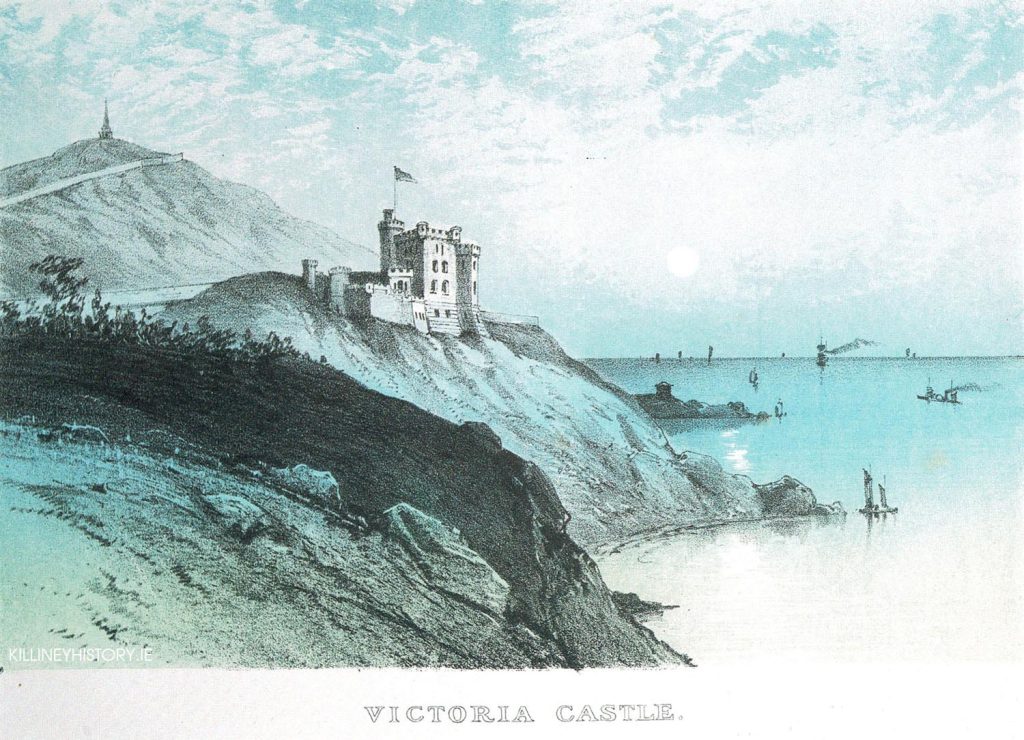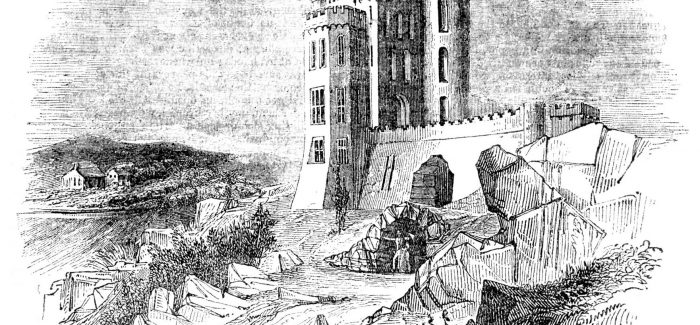Victoria Castle
| Name | Victoria Castle |
|---|---|
| Previous Names | Ayesha Castle, Manderley Castle |
| Address | Victoria Road |
| Year Built | 1840 |
| Architect | Sandham Symes (TBC) |
| Exists today | Yes |
| On 1888 map | Yes |

Article from The Irish Penny Journal of 5th June 1841.
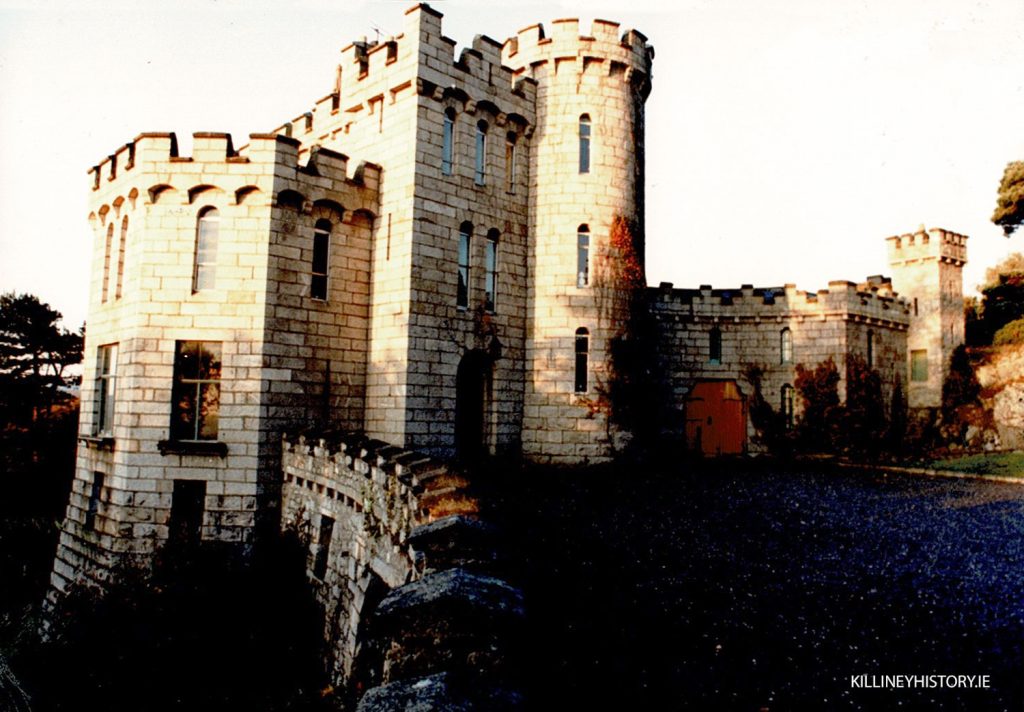
Plans to develop a new town, to be called Queenstown, on the estate of Robert Warren at Killiney Hill were unveiled in 1840. The plans which were drawn up by the architects Hoskin & Son envisaged rows of grand detached and terraced houses circling the hill of Killiney. The only houses which were actually built included Victoria Castle, Mount Mapas and Mount Eagle (then called Coburg Lodge), and these were illustrated in vignettes on the plans. The illustration of Victoria Castle states: ‘already built on Lot No.1’. The article transcribed below from The Irish Penny Journal of the time gives a good idea of the speculative development which was beginning to happen in Killiney and surrounding districts as the railway and roads were being improved and extended. (A rather tongue-in-cheek article gently mocking the fashion for faux castles which were being built at the time, a trait of Robert Warren which we see in his additions to Killiney Castle and his alterations to Baymount House in Clontarf)
The first stone of the new town has been laid; nay, the first building, no less a building than “Victoria Castle” has been actually erected; and, as a memorial of one of the gigantic projects of this speculating nineteenth century of ours, we have felt it incumbent on us to give its fair proportions a place in our immortal and universally read miscellany, in order to hand down its pristine form to posterity in ages when it shall have been shaped by time into a genuine antique ruin.
Of the architectural style and general appearance of Victoria Castle, our engraving gives a good idea. Like most modern would-be castles, it has towers and crenellated battlements and large windows in abundance, and is upon the whole as unlike a real old castle as such structures usually are. It is, however, a picturesque and imposing structure of its kind, and, what is of more consequence to its future occupants, a cheerful and commodious habitation, which is more than can be said of most genuine castles, or of many more classical imitations of them ; and its situation, on a terrace on the south side of Killiney Hill, is one as commanding and beautiful as could possibly be imagined. Nothing in nature can indeed surpass the beauty, variety, and extent of the prospects which may be enjoyed from this spot or its immediate vicinity, and we might fill a whole number of our Journal in describing their principal features.
Available To Let
For many years after their completion Robert Warren made his Killiney properties, including Victoria Castle, available to let. Adverts similar to the one below appeared in 1845 and for a number of years around this time.
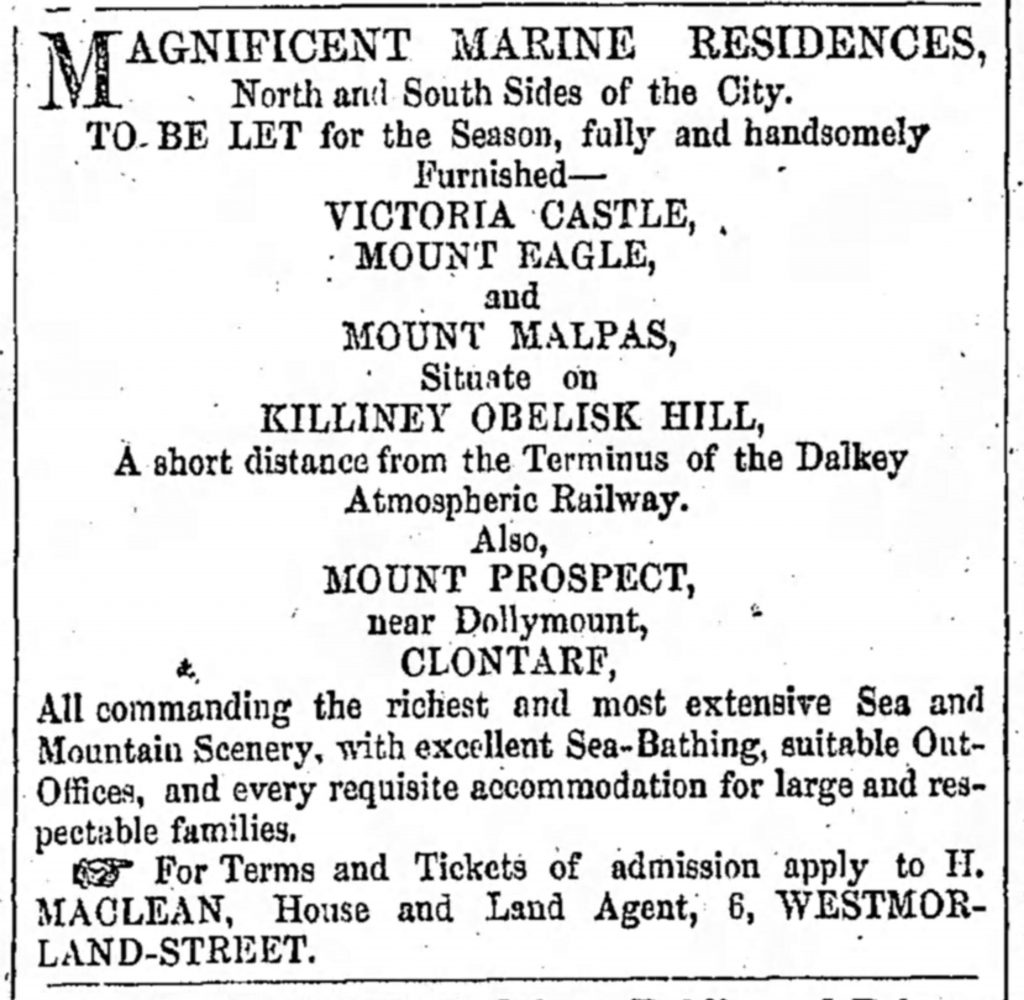
Auction of the bankrupt Warren Estate in 1872
The background to the bankruptcy of Robert Warren can be read here.

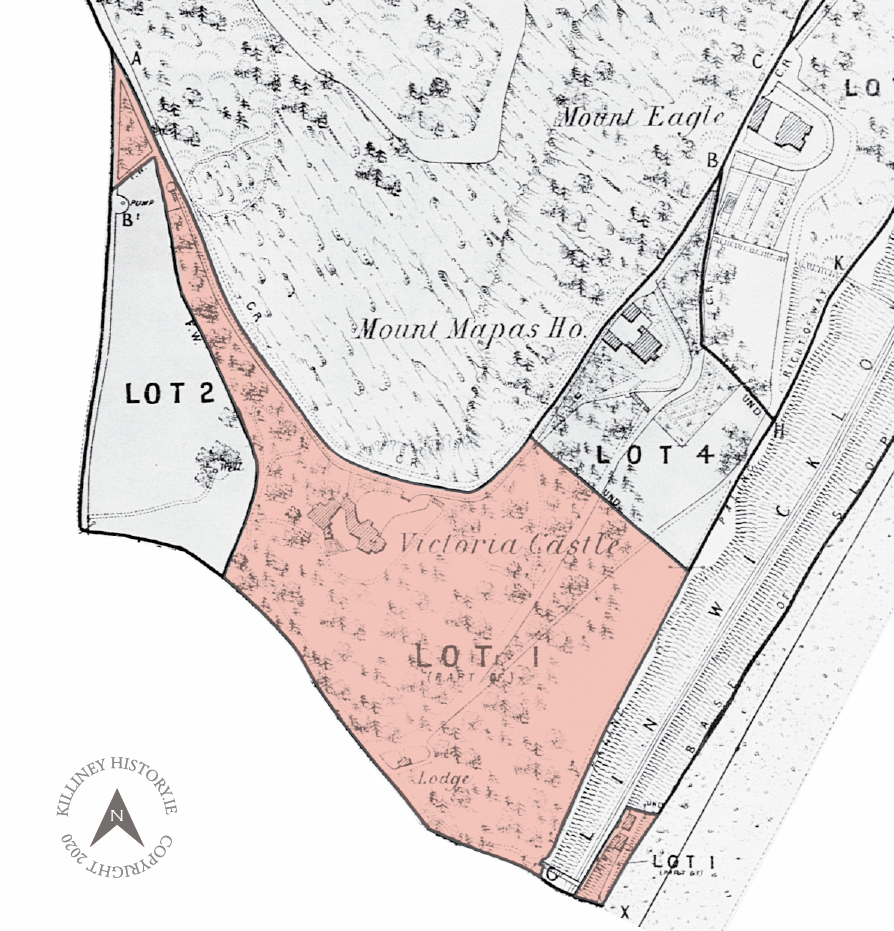
Rev. Humphrey Lloyd 1800-1881
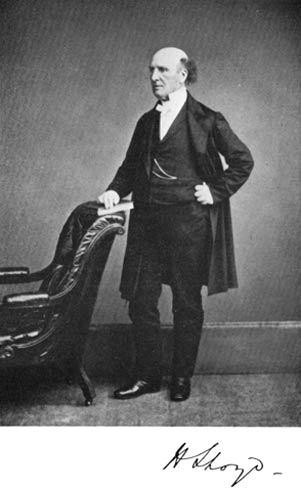
In 1872 Humphrey Lloyd, then Provost of Trinity College, bought Victoria Castle for £5,000-0-0. This provided Warren with sufficient money to settle with his main creditors. The remaining Warren properties were withdrawn from auction when he paid over £11,000-0-0 to the Court.
Humphrey Lloyd, son of Rev. Bartholomew Lloyd, married Dorothea Bulwer in 1840 but they had no children. President of the Royal Irish Academy. He received in 1874 ‘Pour le merite’ from the Emperor of Germany, the Prussian order of the Verdiensthreux or ‘Cross of Merit’.
Clifford B. Lloyd 1845-1915
A nephew of Humphrey Lloyd, (and son of Bartholomew-Clifford Lloyd of Losset, county Cavan,) Clifford B. Lloyd took charge of the property in 1882. The strategic location of this property embroiled the owner in a long negotiation to cede land to allow for the opening of the Vico Road.
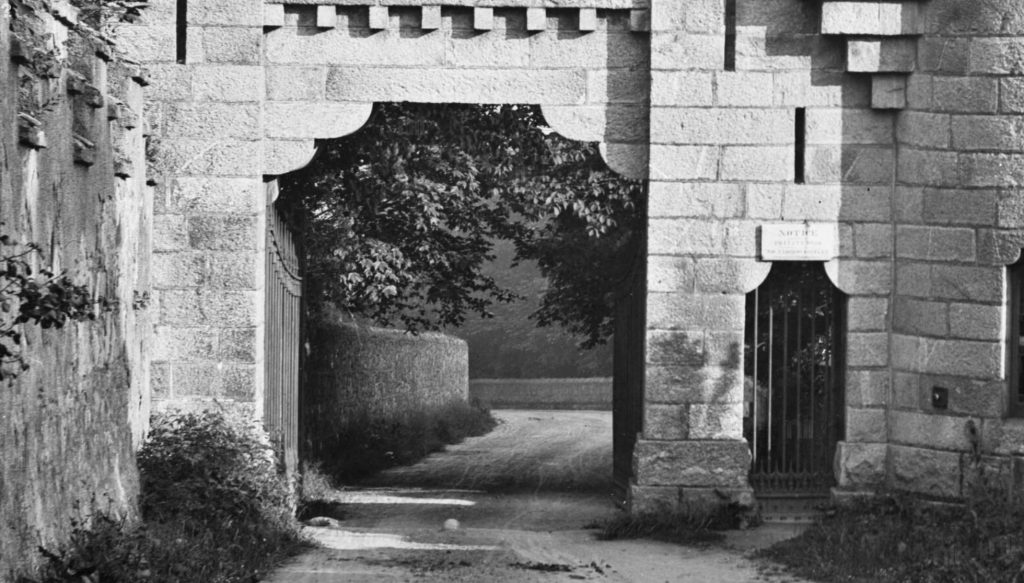
The Victoria Castle estate extended from Killiney village, where it was accessed via the gate lodge at the top of Victoria Road, now known as Camelot, down to the boundary with Mount Mapas. Lloyd did not allow public access over his property and a sign on the wall of the gate lodge read: PRIVATE NO THOROUGHFARE. The gates, since removed, can be seen in this Lawrence collection photograph from c.1880. A newspaper article dated 1st October 1888 reports that: ‘a massive gate bars the way from Killiney village around Killiney Hill and that although some residents have privilege of passage the general public are told that there is ‘no thoroughfare’ by the woman in charge of the lodge.’ The article continues that a similar problem exists with another of Lloyds gates on the lower road leading to Killiney and Ballybrack Station. In a report on the proceedings of Dalkey Township Commissioneers in The Freemans Journal of 20th July 1888 John Munroe reports that he has spoken to Mr. Clifford Lloyd and that he ‘would be disposed to give up the lower road to the public on his getting the exclusive use of the upper road and some other concessions from the trustees.’ The Parks Committee were unable to grant about one acre of Victoria hill which Lloyd was demanding along with walls and a tunnel to be built to serve his property. The trustees of Victoria Park resolved that an arrangement be reached with Lloyd by which the lower road, in continuation of Vico Road, to the old railway station at Killiney should be opened to the public. You can read more about the opening of the Vico Road here.
Harry Clarke memorial window to Clifford B. Lloyd in Holy Trinity Church, Killiney
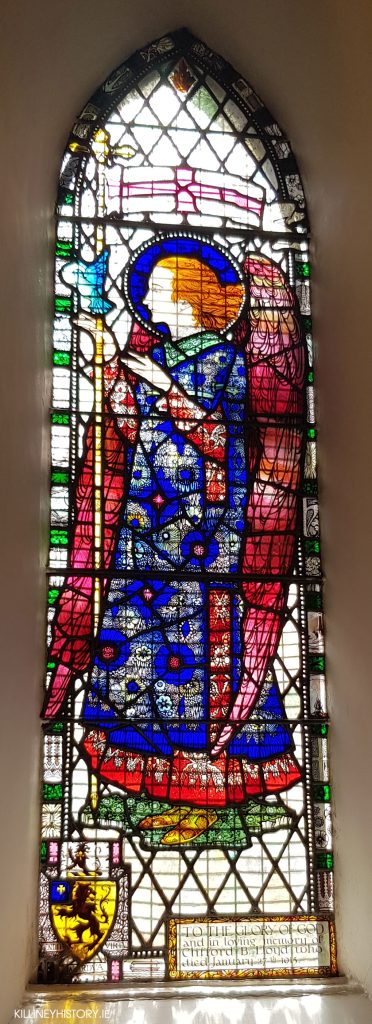
The most famous window was installed in the church in 1919, when Mrs Lloyd of Victoria Castle (now Ayesha Castle) presented it as a memorial to her husband, Clifford, who had died in 1915. She had commissioned the work from Harry Clarke and the result is delightful. This window is known as the Angel of Peace and Hope, which becomes most significant when we realise that, at the time of the commissioning, the First World War was in progress. Clarke himself often referred to this window as the Beardsley window and admitted to being influenced by the work of Aubrey Beardsley when designing it. He was also influenced by an early portrait of Queen Elizabeth I. But whatever his influences, he turned out a small masterpiece, that can be appreciated only when we study all the tiny details, such as the little ships, the flowers, and St Brigid’s crosses and even a tiny Noah’s Ark. According to Nicola Gordon Bowe, Clarke started work on this window in June 1917, when he prepared first designs and submitted them for approval in September, giving an estimate of £70 for the work. It was accepted and he went ahead, having the firing done by The Studios, for which he paid them £22-15s- 0d, when the work was finished in February 1919.
(Source: Holy Trinity Church KIlliney 1858-1996. A Parish History 1996)
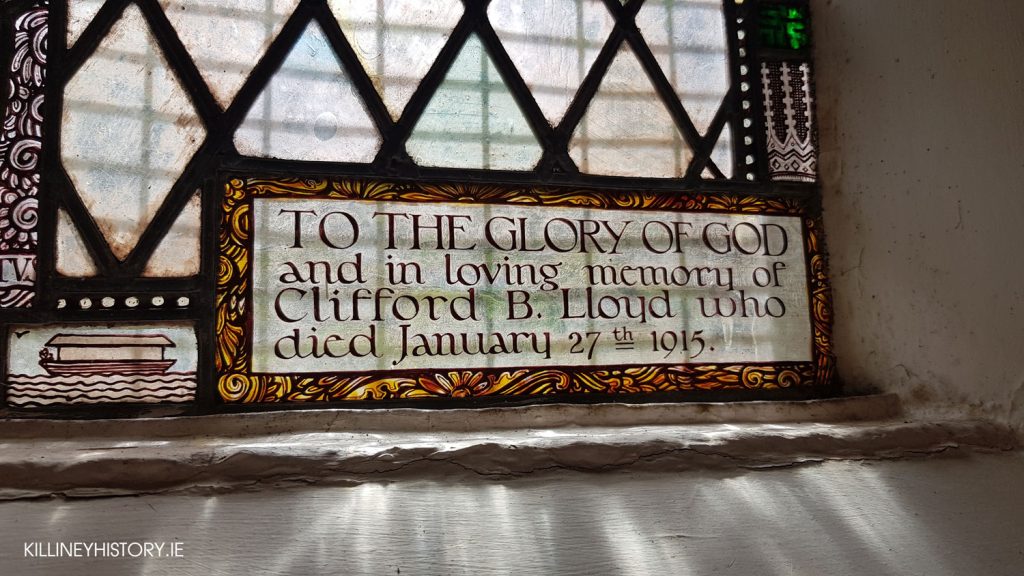
Wilmot Humphrey Clifford Lloyd of Lossett, co. Cavan 1879-
Son of Clifford B. Lloyd and Isabella
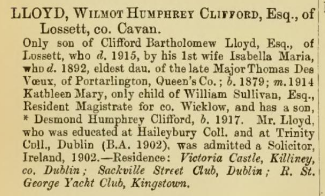
Fire of 1926
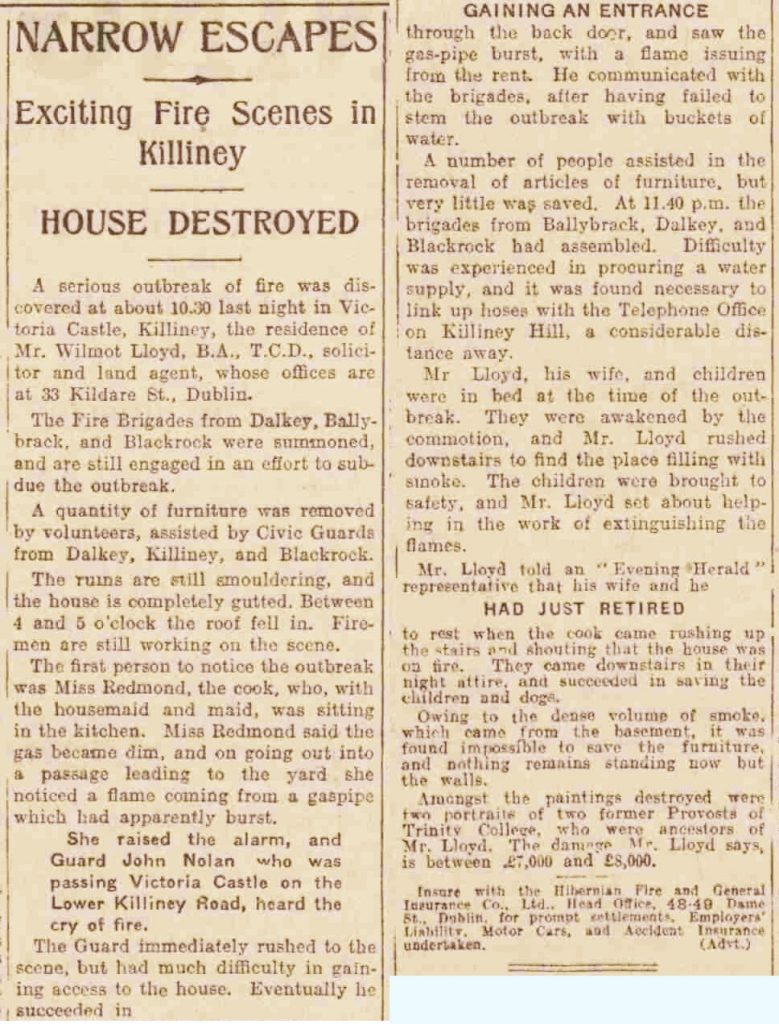
Plans to restore the house in 1927
In 1927 the architects, W.H. Byrne & Sons, were commissioned to look at options for the restoration of the property after the devastating fire of the previous year. The damage must have been significant as a proposal was prepared which indicated the replacement of a very large portion of the remaining building with a ‘bungalow’ retaining the entrance and the semi-basement level kitchen quarters. This plan did not proceed and a careful restoration of the original was executed. It appears the only element which was left out was the roof level turret which was demolished probably due to irreparable fire damage. This was replaced by a rooflight which now lights the main staircase to great effect (see photo below). The following images are courtesy of the Irish Architectural Archive.
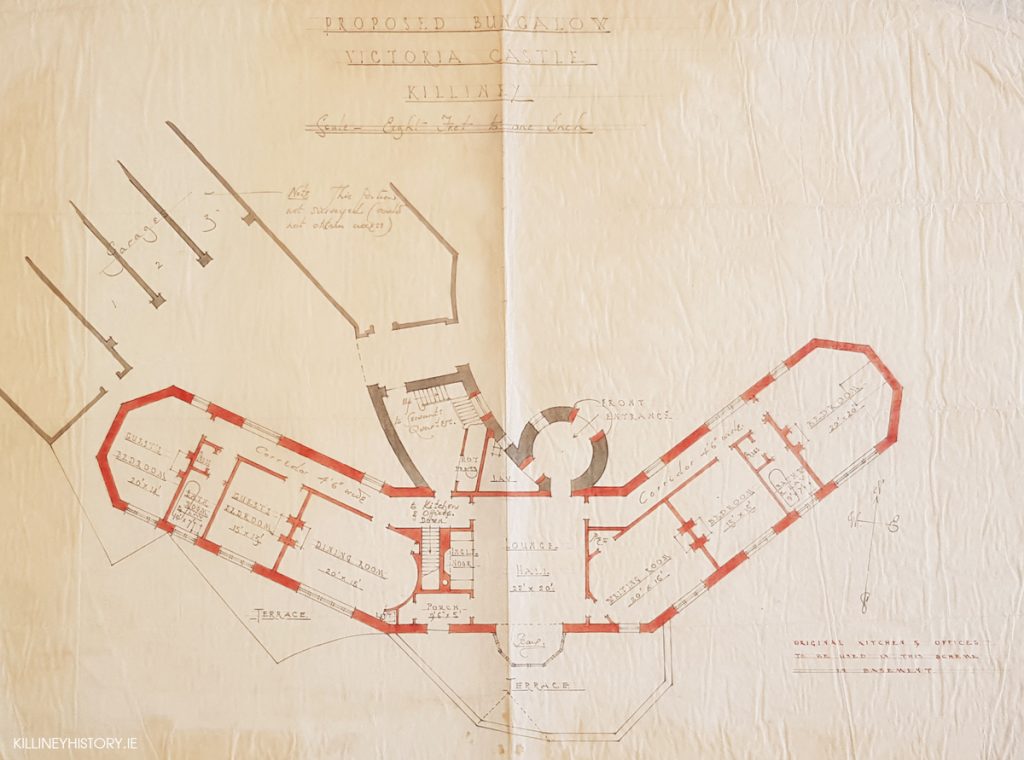
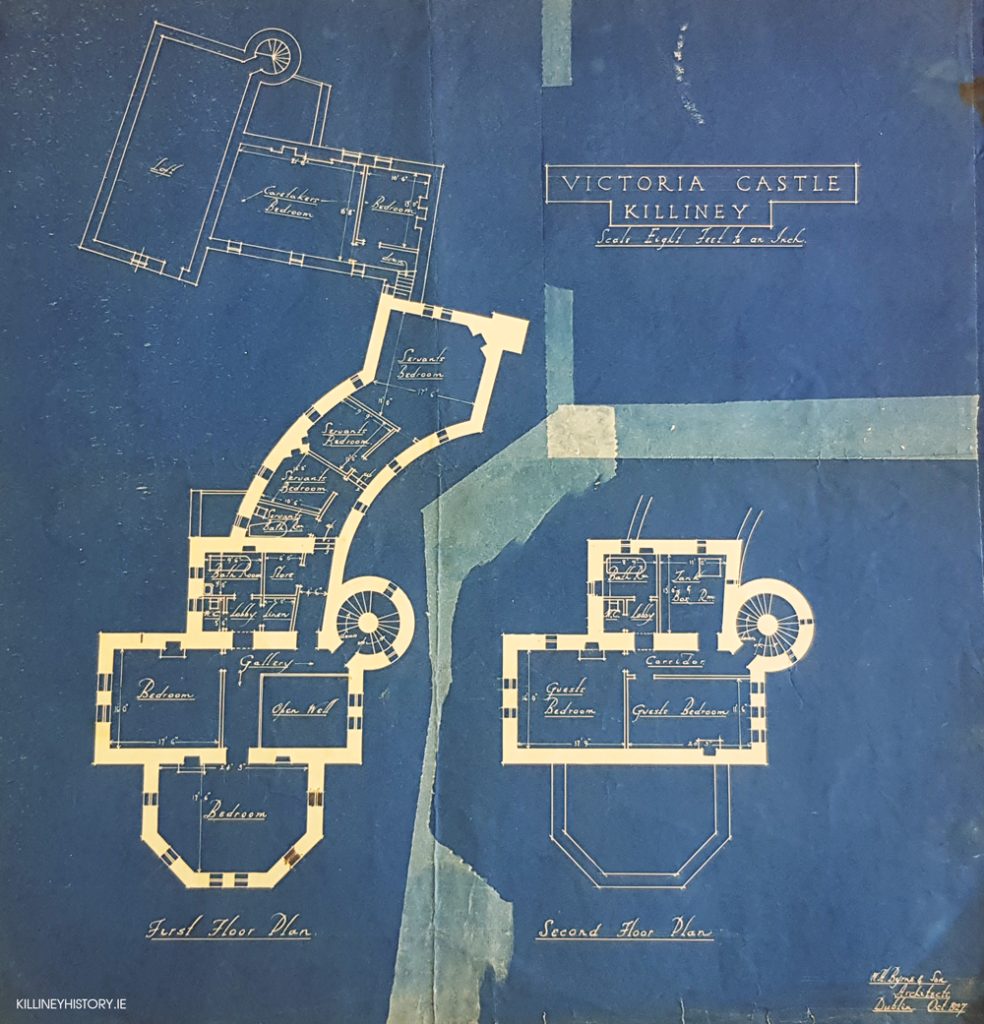

Auction notice of 16th April 1947
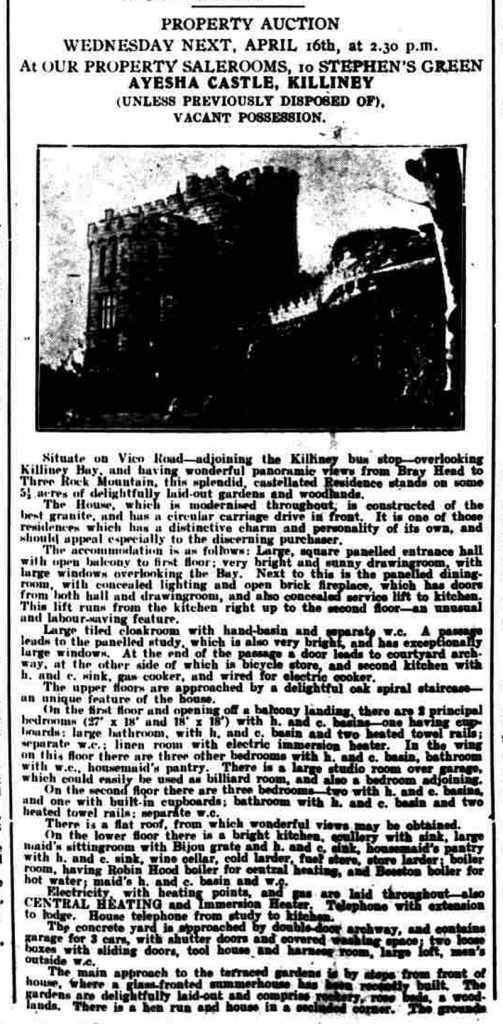
Tour guide to Victoria Castle dated sometime prior to it’s sale to Enya in 1996
Written by a member of the Aylmer family who were resident at the time.
WELCOME TO AYESHA CASTLE THE HOME OF THE AYLMER FAMILY SINCE 1947.
The Castle was completed in 1840 and is built of granite from the Dalkey quarries.
It feature on the front page of the Dublin Penny Journal of 5th June 1841 and was first named Victoria Castle to commemorate the accession of Queen Victoria to the throne in 1837. The first owner was Robert Warren who owned most of Killiney Hill at the time and is responsible for building Killiney Castle (now a hotel) which was his main residence. He used to let Victoria Castle to Viscounts, Merchants etc. one of whom was Viscount Southwell who rented the Castle for £220 per annum in 1870 – 1871.
The Architect for Ayesha Castle is considered to be Sandford (Sandham) Symes who was a relation of Robert Warren and who was also responsible for building Mount Eagle later on the Vico Road and Altadore in Glenageary. This information has been verified by the Senior Architect of the Board of Works, Mr. Frederick O’Dwyer, who is an authority on Victorian Architecture.
Ayesha was for many years the home of the Lloyd family and particularly Rev. Humphrey Lloyd a former provost of Trinity College Dublin (1867). He was also made a fellow of the Royal Society in England for his thesis on light and was given a special award by the German Government for work he had done for them. The Lloyd family lived at Ayesha from approx. 1880 – 1928. Victoria Castle as it was then known was gutted by fire in 1928 and in 1930 the house was purchased by Sir Thomas Power of Power’s Whiskey fame. He is responsible for restoring the Castle to its present state. The magnificent oak staircase of 64 steps, the fine oak panelling in the hallway and Dining Room, the latter which is arguably the finest room in the house. The Castle was renamed in 1930 to Ayesha by Sir Thomas Power who named it after the goddess in Ryder Haggard’s Book “She” because like the goddess Ayesha rose from the flames.
In 1937/1938 Ayesha changed hands and passed into the Barrett family (the same family as Barrett Cheshire Home in Herbert Street, Dublin).
After the death of John Chalk Barrett his widow sold Ayesha to the late Colonel Richard Michael Aylmer father of the present owner.
Here in the Hallway to the right hand side of the Front Door we see the Coat of Arms of the Aylmer family, 4 cornish choughs with wings displayed and ducal crown, with the famous motto or warcry “Hallelujah”. The Aylmer’s of Ireland have been in Kildare since the 11th Century and the name originated from Cornwall and Athalmer which became Aylmer. They came to Ireland with Strongbow who as you know is buried in the crypt of Christ Church Cathedral. For 500 years the Aylmers lived at Lyons House at Newcastle near Celbridge (now the Agricultural College of UCD) and by the middle of the 19th Century they were the largest landowners in North Kildare. Many of their lands had been fought for in earlier years with Irish Clans like the O’Tooles. Some had been granted to them by the Crown.
By 1850 although they had lost Lyons House they owned seats at Donaghdea Castle, Kerdiffstown and later Courtown of Kilcock and Rathmore as well as valuable lands at Tully which is now the National Stud.
Some landmarks are to this day a feature in Co. Kildare e.g. Aylmer Road and Aylmer Bridge at Newcastle. Also the famous Aylmer’s Tower at the Hill of Allen near Newbridge which was built by Sir Gerald Aylmer, 8th Baronet of Donaghdea who gave employment to the men from the Allenwood area during 1859-1863 and arranged for the name of each man employed in the Building Work to be carved for posterity on each step inside the Tower. King Edward VII ascended the Tower on his last visit to Ireland. At Balrath on the road to Slane (Co. Meath) there stands a Cross which Sir Andrew Aylmer had erected in honour of the Bathe family. This is now a National Monument.
Description by Peter Pearson 1998
Peter Pearson ‘Between the Mountains and the Sea‘ (1998), pp.61-62.

Victoria Castle, renamed Ayesha Castle in 1930, was one of Warren’s projects which was successfully completed. A pseudo Norman castle, built of local Dalkey granite, it is dramatically situated on the side of Killiney Hill with excellent views towards Bray and the Wicklow mountains. Victoria Castle, with its impeccably cut stonework is essentially square in plan, with a large, half-octagonal, projecting block and a circular tower. It is approached from a terrace or forecourt and has rather severe, round-headed, narrow windows and a plain entrance door. The silhouette is very striking with its many crenellations and battlements. The architect may have been Sandham Symes, who is recorded as the designer of Mount Eagle, another Warren development. Victoria Castle was occupied from 1880 until 1927 by the family of Clifford Lloyd, a solicitor. The Lloyd family were kin of Provost Lloyd of Trinity College Dublin. Then its interior was gutted by an accidental fire. It was bought by Sir Thomas Talbot Power, owner of Power’s distillery, who used his considerable wealth to restore it to its present condition. Power, who had bought the ruin for £1800, created an impressive interior with an oak-panelled hall and dining room and a magnificent spiral staircase. He re-named the castle `Ayesha’ after a fictional goddess who rose from the flames in Ryder Haggard’s book ‘She’. Ayesha Castle was sold in 1996 to the Irish singer Enya for over £2 million.
Records from Thom’s Directory
RESIDENTS OF VICTORIA CASTLE
1847-1852 Robert Warren
1856-1858 Robert Warren Junior
1860 No Reference
1870-1871 Rt. Hon. Lord Southwell
1872-1881 Rev. H. Lloyd, Provost, Trinity College Dublin
1882-1916 Clifford B. Lloyd
1917-1918 Vacant
1919-1927 Wilmot Lloyd
1928 Vacant
1930 Sir Thomas Talbot Bart. Power (Listed as Ayesham)
1932-1933 Not listed
1934 Vacant
1935-1938 John Edward Pearce
1939-1940 Vacant (Listed as Ayesha Castle)
1941-1942 Right Hon. John Hall Kelly, Canadian High Commissioner to Eire *check dates
1943-1946 John C. Barrett (Listed as Ayesham Castle)
1947-1955 Colonel Richard. M. Aylmer
